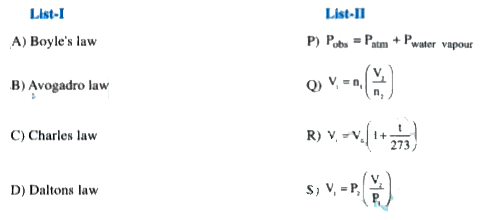In ion-dipole forces, the magnitude of the interaction energy (E)Solution in Telugu
E=Z2μr2
E=Zrμr
E=Zμ2r2
E=Zμr2
The correct Answer is:D
Step by step video, text & image solution for In ion-dipole forces, the magnitude of the interaction energy (E) by Chemistry experts to help you in doubts & scoring excellent marks in Class 12 exams.
Updated on:21/07/2023Topper's Solved these Questions
- STATES OF MATTER BOOK - AAKASH SERIESCHAPTER - STATES OF MATTER EXERCISE - LECTURE SHEET (EXERCISE-I) (LINKED COMPREHENSION TYPE QUESTIONS) Passage-I
5 Videos
- STATES OF MATTER BOOK - AAKASH SERIESCHAPTER - STATES OF MATTER EXERCISE - LECTURE SHEET (EXERCISE-I) (MATRIX MATCHING TYPE QUESTIONS)
2 Videos
- SOLUTIONS BOOK - AAKASH SERIESCHAPTER - SOLUTIONS EXERCISE - Objective Exercise -4
50 Videos
- STOICHIOMETRYBOOK - AAKASH SERIESCHAPTER - STOICHIOMETRYEXERCISE - PRACTICE SHEET (ADVANCED) (INTEGER TYPE QUESTION)
2 Videos
Similar Questions
Variation of volume with temperature was first studied by French chemist, Jacques Charles, in 1787 and then extended by another French chemist Joseph Gay-Lussac in 1802. For a fixed mass of a gas under isobaric condition, variation of volume V with temperature t°C is given by V = V0[l+αt] where V0 is the volume at 0°C, at constant pressure.
1 or every 1° change in temperature, the volume of the gas changes by............... of the volume at 0∘ C
View Solution
View SolutionAssertion : Molarity of a solution decreases with an increase of temperature
Reason : As temperature increases volume of the solution increases.
View SolutionAmmonia is oxised by oxygen to give nitric oxide and water. The weight of water produced per gram of nitric oxide is 0.1×xg. What is value of d.
View SolutionWhich of the following intermolecular force is vander Waals interaction
(i) Ion dipole, (ii) Dipole -Dipole
(iii) Ion - induced dipole
(b) Which of the following intermolecular forces ion nonvan ber Waals interaction
(i) Dipole induced dipole
(ii) Instantaneous dipole induced dipole
(iii) Ion- induced dipole
(iv) None
(c ) Which of the foolowing intermolecular forces have a potential energey distance function as E∝1r2
(i) Ion -dipole (ii) Dipole -dipole (iii) Ion -induced dipole (iv) London dispersion forces .
View SolutionION-DIPOLE INTERACTIONS
View SolutionION-INDUCED DIPOLE INTERACTION
View SolutionAssertion :- Ion-induced dipole interaction is stronger than dipole-induced dipole interaction. Reason :- Accumulated charges on the molecule in case of ion-induced dipole is more compared to that in case of dipole interaction.
View SolutionAssertion : Dipole - dipole forces acting between the molecules possessing permanent dipole , are weaker than ion - ion interactions .
Reason : The attractive forces decrease with the increase of distance between the dipoles .
View Solutionनाइलॉन में अन्तराअणुक बल द्विध्रुव - द्विध्रुव अन्योन्य क्रिया है।
View Solutionअभिकथन : स्थायी द्विध्रुव रखने वाले अणुओ के मध्य क्रियाशील द्विध्रुव-द्विध्रुव बल, आयन-आयन अन्योन्य क्रियाओ की तुलना में कमजोर होते हैं |
तर्क : आकर्षण बल, द्विध्रुवों के मध्य दूरी के बढ़ने पर कम होते हैं |
View SolutionGive interaction energy of the following : (i) London forces (ii) Dipole - Dipole forces (iii) Dipole - induce forces.
View SolutionGive magnitude of energy of force and value of interaction process with example.
View SolutionArrange increasing order of energy of interaction forces London force, Covalent bond, Hydrogen bond, Dipole - Dipole forces.
View SolutionA system of two electric dipoles, each of dipole moment having magnitude P are arranged in the configuration shown in figure The electrostatic interaction energy of this systm of two dipoles is :

View Solution
